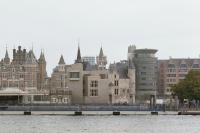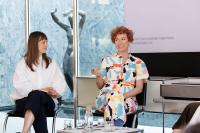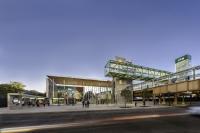Employee Restaurant Boehringer Ingelheim
Biberach, Germany
The Project – For the past more than five decades the pharmaceutical company Boehringer Ingelheim has operated a large site in Biberach/Riss with today approximately 3.800 employees. In the last five years the factory has been developed into a modern research site with further jobs in biotechnology and medicine. Scientists from all over the world are searching here for new active ingredients and the optimal means of creating effective medications out of them and to provide it for patients worldwide. One of the worldwide biggest production sites for biotechnological medicaments were established here. Therefor 250 Million Euro were invested.
Boehringer Ingelheim has been a family enterprise with social ambitions for more than 100 years. Providing appropriate catering for employees at their respective locations is part of this perceptible attitude and of a corporate culture that is out of appreciation and responsibility:
"Employee Restaurant" was the name of the somewhat reserved title of the building task which was assigned to the Architects Kauffmann Theilig & Partner (KTP) in 2001 following a competition.
The Urban Planning Situation – The moderate height of the new restaurant mediates between the small scaled residential area and the multi-story institutional buildings lying behind it. Also located near the north gate is one of the two entrances to the factory premises. The solitary figure of the Employee Restaurant sits securely on the triangularly shaped site. With a wide embrace, the building grounds encompass the surroundings and so provide the necessary freedom for the solitary building. Floor to ceiling glazing creates flowing transitions between the interior and exterior and thus allows the guest space to participate in the newly gained generosity.
The guest space – Approximately 2.200 employees in 680 seats dine underneath a modulated, extensive wooden roof landscape. Formally designed stone-like volumes support the roof and contain the infrastructure for the guest space. The structural details of the roof structure above the guest space are not apparent: much more, a spatial, wooden folded-plate structure crosses the great, apparently column-free, guest space. It simultaneously achieves the significant cantilevers, each of which completes the logic of this form. The volumes, realized in concrete, grow upwards (stalagmites) and the roof elements, formed in wood, grow downwards (stalactites). Together they subdivide the generous, flowing guest space into different areas.
Various meals are offered in a market area at seven round food stations. The distribution stations, with their directed air outlets, etc. are technically very highly stressed building components. Yet the elements are constructed so that no constraints are apparent: The cooks distribute the freshly prepared dishes almost playfully from behind furniture-like counters made of natural stone and stainless steel. The kitchen area, in the traditional sense, is reduced to a few spaces for food preparation and for automated dish washing. These are organized in an orthogonal, efficient structure together with the cool rooms, storage rooms, the employees lounge and changing areas, and the delivery area with office units. Two parallel corridors provide separate circulation to the provision and waste removal areas.
Cafeteria and conference – A cafeteria with a further 220 seats extends the offer on the ground floor. Here the employees are explicitly offered a change of place, or those who are in a rush can get a quick meal in between. Generous outdoor areas create an additional offering in summertime; Floor to ceiling glazing connects the interior with the exterior. In comparison to the main elegant and plain guest space, the specifically different character here is achieved through elated, more colorful furnishings.
A bridge-like upper level crosses over the previously described guest space. The guest casino is located here. The corridors and circulation zones are generously glazed, thus achieving a spatial connection to the guest space. Aside from the possibility of serving the company’s visitors individually, there are four variously sized conference rooms located here which can be joined together. Suited to the occasion, the formal workmanship of the space dividers is completed with high-end wooden surfaces which are sculptural and worked with reduced motifs. The technical characteristics of the spaces (conference technology, etc.) remain in the background.
Client
Boehringer Ingelheim Pharma GmbH & Co. KG
Architecture
Kauffmann Theilig & Partner
Ostfildern
Project manager
Armin Fiess
Project architects
Christian Übele, Jakob Eckert, Jochen Zink, Carolin Eltner, Steffi Runknagel, Irina Wenske, Jörg Karlitschek
Supervision
KTP with soe Stinner & Von der Oelsnitz
Weingarten
Structural Engineer
Pfefferkorn Ingenieure
Stuttgart
HVAC & Plumbing
Schreiber Ingenieure
Ulm
Electrical Engineer
Werner Schwarz GmbH
Stuttgart
Kitchen Planner
LZ-Plan-Team
Hamburg
Climate Concept
Transsolar Energietechnik
Stuttgart
Construction Physics
Horstmann + Berger
Altensteig
Light Planner
Flashaar Ingenieure
Bingen am Rhein
Fire Protection
Halfkann + Kirchner
Erkelenz
Building costs total
16,0 Mio. €
Gross floor area
7.500 m²
Gross volume
31.000 m³
Work phases acc. to HOAI
1 - 9
Competition
1st prize 06/2001
Planning start
03/2002
Construction start
04/2003
Construction completion
08/2004
Awards
Nomination AAA Austrian Architecture Award 2005
Award Deutscher Stahlbaupreis 2006
Frankfurter Prize - „Oscar of Gastronomy“
- Architects
- K T P Kauffmann Theilig & Partner
- Location
- Birkendorferstraße 65, 88397 Biberach, Germany
- Year
- 2004

















